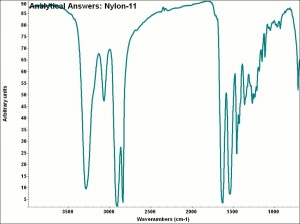Nylon 11
Description
Nylon 11 is composed of polymerized 11-amino-undecanoic acid. Nylon 11 was originally made from castor bean oil and marketed under the trademark of Rilsan®. Nylon 11 fibers have similar properties to nylon 6 and 6,6. Nylon 11, however is less dense, melts at a lower temperature and has better dimensional stability. It is often used for brush bristles, lingerie, bulked yarns, and injection molded plastics.
See also nylon fiber.
Synonyms and Related Terms
PA11; polyamide 11; polyundecanamide; Nylon® [Du Pont]; Rilsan® [Arkema]; Rilsanite®
Other Properties
Resistant to alkalis and most organic solvents. Degraded by concentrated acids and phenol. Burns with yellow-orange flame and blue smoke; smells of burnt horn. Fiber is smooth. Cross section is circular. Tenacity = 5.0-7.5 g/denier (dry or wet); Elongation = 25% (dry or wet); Moisture regain = 1.18%
| Melting Point | 189 |
|---|---|
| Density | 1.04 |
Additional Information
G.Cook, Handbook of Textile Fibres:II. Man-made Fibres, 5th edition, Merrow Publishing Co., Durham, England, 1984.
Authority
- G.S.Brady, Materials Handbook, McGraw-Hill Book Co., New York, 1971 Comment: p. 553
- Richard S. Lewis, Hawley's Condensed Chemical Dictionary, Van Nostrand Reinhold, New York, 10th ed., 1993
- Marjory L. Joseph, Introductory Textile Science, Holt, Rinehart and Winston, Fort Worth, TX, 1986
- J.Gordon Cook, Handbook of Textile Fibres:II Man-made Fibres, Merrow Publishing Co. , Durham, England
- Website address 1 Comment: www.astm.org
- F. Kidd, Brushmaking Materials, Bristish Brush Manufacturers, London, 1957
